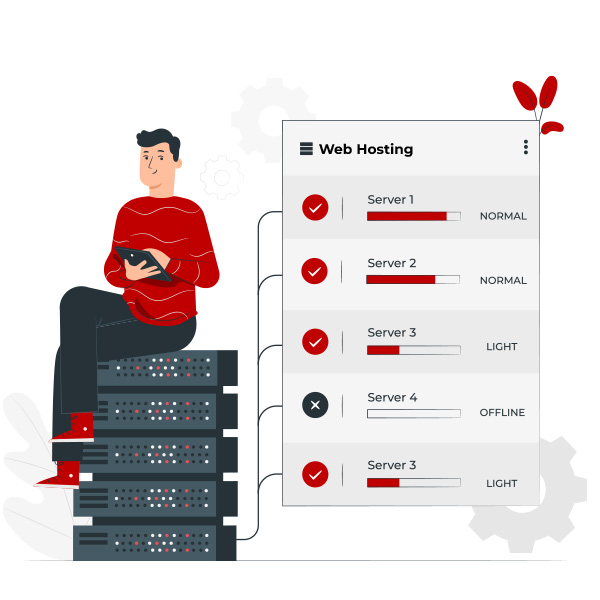
Here is the Top 12 Techniques to Website Speed Optimization :

1. Use a Content Delivery Network (CDN)
A content delivery network is a set of web servers distributed across various geographical locations that provide web content to end users concerning their location. When you host the website on a single server, all user requests are sent to the same hardware. For this reason, the time needed to process each request increases. On top of that, the load time increases when users are physically far from the server. With CDN, user requests are redirected to the nearest server. As a result, the content is delivered to a user quicker and a website works faster. This is a rather expensive, but quite effective way to optimize the load time.
2. Move your website to a better host
There are three possible types of hosting:
- Shared Hosting
- Virtual Private Servers (VPS) hosting
- Dedicated server
The most popular type of hosting that is used all over the world is shared hosting. That’s the cheapest way to get your site online in a short time and for a low fee. It’s essential to choose a fast web host to ensure better optimization. With shared hosting, you share CPU, disk space, and RAM with other sites that also use this server. This is the main reason why shared hosting isn’t as fast as VPS or a dedicated server.
Virtual Private Servers and dedicated servers are much faster. VPS uses multiple servers for content distribution. Having VPS you share the server with its other users and have your own part of the virtual server where your configurations don’t influence other clients. If your website has the average traffic or you have an eCommerce site with traffic spikes in some periods, VPS will be the optimal solution for you.
The most expensive hosting option is to use a dedicated server which can be your own physical server. In this case, you pay a server’s rent and hire a system administrator to maintain it.
3. Optimize the size of images on your website
Everyone loves eye-catching images. In the case of successful eCommerce sites, images are the vital part. Lots of photos, images, and graphics on your product pages improve engagement. The negative side of the image use is that they are usually large files that slow down a website.
The best way to reduce the image size without compromising its quality is to compress images using such tools as ImageOptim, JPEGmini, or Kraken. The procedure may take a bit of time but it’s worth it. Another way to reduce the image size is to use the HTML responsive images <secret> and <size> attributes that adjust image size based on user display properties.
4. Reduce the number of plugins
Plugins are common components of each website. They add specific features suggested by third parties. Unfortunately, the more plugins are installed, the more resources are needed to run them. As a result, the website works slower, and also security issues can appear. As time passes, the number of plugins grows, while some of them may not be used anymore. We recommend checking out all the plugins you have installed and deleting unnecessary ones. First, run the performance tests on your page to find out which plugins are slowing down your website. Not only does the website speed depend on the number of installed plugins but also on their quality. Try to avoid plugins that load a lot of scripts and styles or generate a lot of database queries. The best solution is to keep only the necessary ones and ensure that they are kept up to date.
5. Minimize the number of JavaScript and CSS files
If your website contains a lot of JavaScript and CSS files, it leads to a large number of HTTP requests when your website visitors want to access particular files. These requests are treated individually by the visitor’s browser and slow down the website work. If you reduce the number of JavaScript and CSS files this will undoubtedly speed up your website. Try to group all JavaScript into one and also do so with all CSS files. This will reduce the overall number of HTTP requests. There are a lot of tools to minify HTML, CSS, and JavaScript files quickly. For instance, you can use WillPeavy, Script Minifier, or Grunt tools.
6. Use website caching
In case there are a lot of users accessing the page at one time servers work slowly and need more time to deliver the web page to each user. Caching is the process of storing the current version of your website on the hosting and presenting this version until your website is updated. This means that the web page doesn’t render over and over again for each user. The cached web page doesn’t need to send database requests each time.
The approaches to website caching depend on the platform your website is developed. For WordPress for instance, you can use the following plugins: W3 Total Cache or W3 Super Cache. If you use VPS or a dedicated server, you can also set up caching under your general settings. In the case of the shared server, website caching isn’t usually available.
7. Implement Gzip Compression
Gzip Compression is an effective way to reduce the size of files. It minimizes the HTTP requests and reduces the server response time. Gzip compresses the files before sending them to the browser. On the user side, a browser unzips the files and presents the contents. This method can work with all files on your website. You can enable Gzip on your website by adding some lines of the code or via a utility called Gzip.
8. Database optimization in CMS
Database optimization is an effective way to increase performance. If you use a content management system (CMS) packed with complex plugins, the database size increases and your website works slower. For instance, the WordPress CMS stores comments, blog posts, and other information that takes up a lot of data storage. Each CMS requires its own optimization measures and also has several specific plugins. For WordPress, for example, you may consider WP-Optimize.
9. Reduce the use of web fonts
Web fonts have become very popular in website design. Unfortunately, the use of web fonts harms the speed of page rendering. Web fonts add extra HTTP requests to external resources. The following measures will help you reduce the size of web font traffic:
- Use modern formats WOFF2 for modern browsers;
- Include only those character sets that are used on the site;
- Choose only the needed styles
10. Detect 404 errors
A 404 error means that a “Page isn’t found”. This message is provided by the hosting to browsers or search engines when the accessed content of a page no longer exists. To detect and correct a 404 error, you can use error detection tools and plugins. As we mentioned, additional plugins can negatively affect your website speed, so we advise running the resource through external tools for error detection. For instance, Xenu’s Link Sleuth, Google Webmaster Tools (GWT), and 404 Redirected Plugin For WordPress.
Once you’ve detected all 404 errors, you need to assess the traffic that they generate. If these dead links no longer bring any visits and thus never consume your server resource, then you may leave them as they are. If these pages still have some traffic coming, consider setting redirects for external links and fixing the link addresses for the internal ones.
11. Reduce redirects
Website redirects create additional HTTP requests which negatively impact performance. We advise to keep them to a minimum or eliminate them entirely. First, you should identify all redirects on your page by running a site scan. You can use Screaming Frog to quickly identify redirects. Then you must check if they serve a necessary purpose and leave only the critical ones.
12. Use prefetching techniques
Prefetching entails reading and executing instructions before a user initiates them. The technique is rather common. It works well if you can anticipate user actions and, for instance, load some content or links in advance. Usually, modern browsers allow for prefetching by default as they assume user behavior patterns. However, UX specialists and engineers are more likely to understand user behavior and make “hints” for browsers to do prefetching work.
There are three main types of prefetching:
DNS-prefetching. The practice entails resolving domains into IP addresses in advance.
Link Prefetching. If you are sure that a user will click on a specific link to navigate to some page, you can apply this type of prefetching. The method is useful for stable user journey actions, like moving to the shopping cart page after one or several items were added.
Prerendering. This approach means rendering an entire page or some elements of it in advance.
While prefetching is effective, it requires deep user behavior analysis to make precise assumptions.
Conclusion
Currently, a typical user expects web pages to load in less than 3 seconds. If you don’t meet this expectation barrier, you lose a lot of website traffic and, as a result, your revenue.
So, we recommend applying a simple yet effective website speed optimization approach:
- Check and evaluate the key factors of website success, considering conversion, visibility, and usability.
- Test your current website speed and prioritize the pages and features that need the most attention regarding these three factors.
- Start your optimization with the most speed-reducing aspects and focus on the pages that define your conversion success the most.



